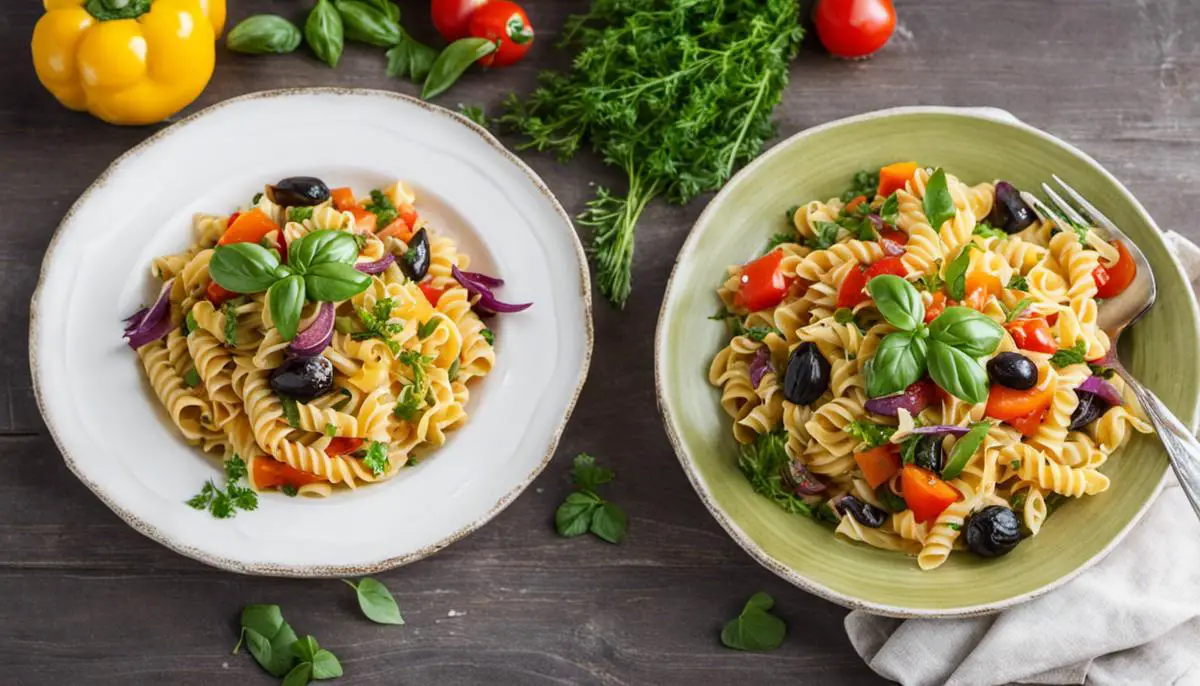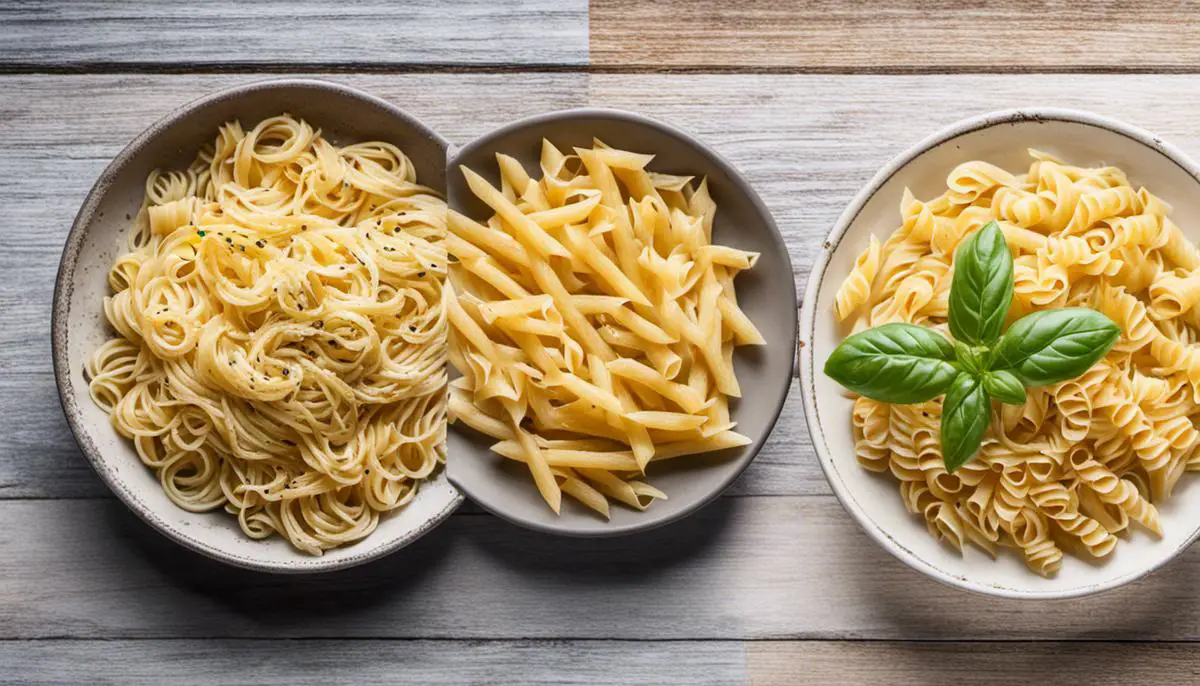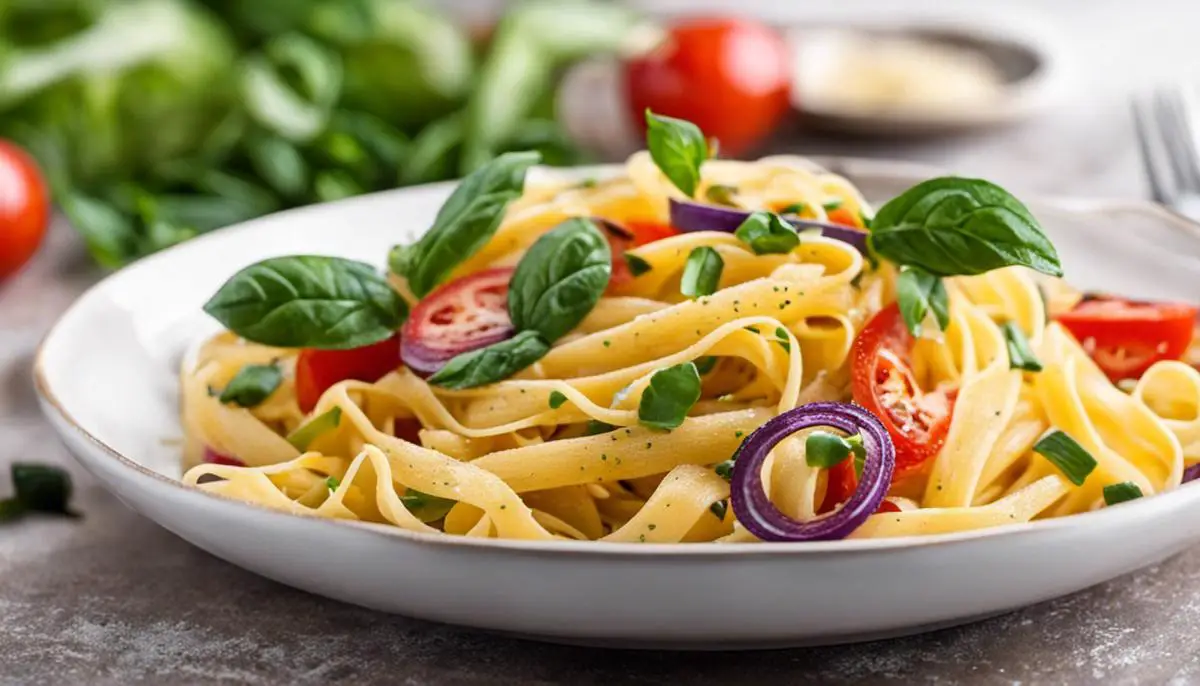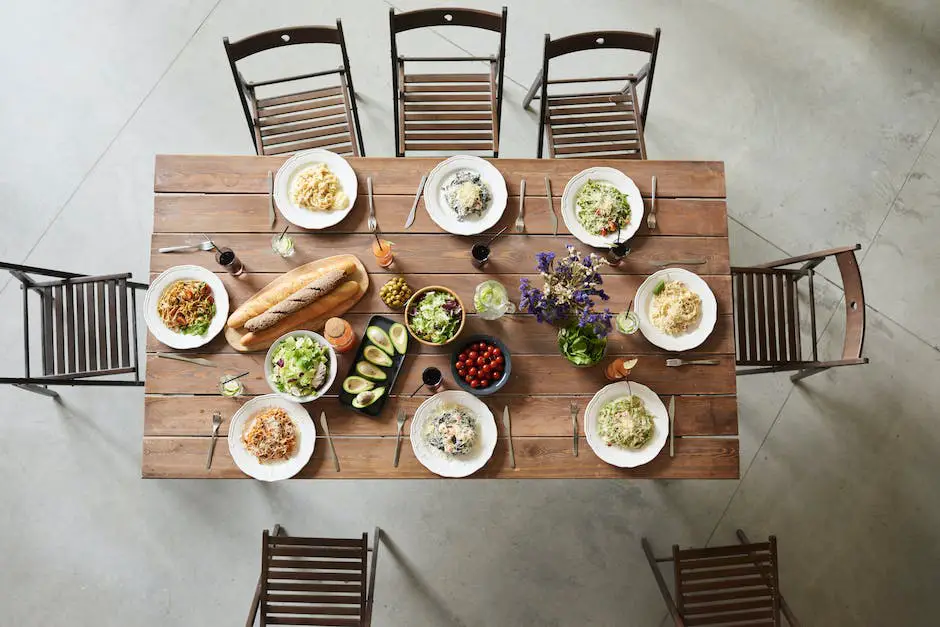Table of Contents
Exploring the realm of gluten-free food options can be enlightening, especially for those who suffer from celiac disease, gluten sensitivity, or simply prefer a gluten-free diet. One food product that has seen a significant amount of innovation in the gluten-free world is pasta. From understanding what gluten-free pasta is, to a nutritional comparison with regular pasta, to how to cook and savor it, and finally reviewing some of the best brands in the market, this article covers all aspects of gluten-free pasta. Buckle up, as we take you on a journey through the world of gluten-free pasta, a healthier choice that doesn’t compromise on taste.
Understanding Gluten-Free Pasta
Gluten-free Pasta: Exploring the Options
Gluten is a type of protein found in grains such as wheat, barley, and rye. In most pastas, it is the key element that gives the pasta its structure and texture. However, for some individuals, consumption of gluten can lead to serious health problems. For instance, those with celiac disease, an autoimmune disorder, cannot process gluten and when ingested, it can cause damage to their small intestine. Wheat allergies and non-celiac gluten sensitivity are two other conditions that can cause adverse reactions to gluten.
What is Gluten-free Pasta?
Gluten-free pasta, as the name suggests, is pasta that is made without gluten-containing grains. Instead, it is made with a variety of other grains or legumes that do not contain gluten. The aim of gluten-free pasta is to offer a pasta eating experience that closely resembles that of regular pasta, but without causing any adverse health effects to those who are sensitive to gluten.
Types of Gluten-free Pasta
There is a large variety of gluten-free pasta available on the market today to cater to the growing needs of those choosing or needing to follow a gluten-free diet. Gluten-free pasta might be made from brown rice, corn, quinoa, lentils, or other gluten-free grains.
Brown Rice Pasta
Brown rice pasta is a popular choice among gluten-free options. It is made from ground brown rice, instead of wheat. It has a nutty flavor and is rich in fiber compared to traditional pasta. However, it tends to be a bit chewier than regular pasta and could get mushy if overcooked.
Corn Pasta
Corn pasta is another type of gluten-free pasta. It has a similar color to traditional pasta and keeps its shape well when cooked. It can have a slightly sweet flavor due to the natural sweetness of corn.
Quinoa Pasta
Quinoa pasta, made from quinoa grains, is yet another gluten-free alternative. Quinoa is known as a superfood due to its high protein content and other nutrient values. Quinoa pasta has a firm texture and a rich, earthy flavor.
Lentil Pasta
Lentil pasta is made with lentil flour. It is not only gluten-free but also high in protein and fiber. It has a more robust flavor compared to other gluten-free alternatives and has a firm, al dente texture when cooked.
Cooking Tips and Considerations
Regardless of the type of gluten-free pasta chosen, it is important to note that the cooking time for gluten-free pasta might differ from traditional pasta. They usually cook faster and are best served al dente. Also, since gluten-free pastas are made from different grains, each may have a distinct taste and texture, offering a unique dining experience for each. It may take a bit of experimenting to find the type of gluten-free pasta that best suits individual tastes and dietary needs.
Making Informed Choices for Gluten-free Pasta
Deeper consideration goes into picking gluten-free pasta than one might initially think. The first aspect to be mindful of is label reading. Ensuring that the pasta carries an authentic gluten-free certification should be top priority. Checking for cross-contamination is another essential step, which involves making certain that the pasta has not come into contact with grains containing gluten during its processing. This is especially vital for individuals who have celiac disease.

Nutritional Comparison
A Closer Look at Gluten-free Pasta vs. Traditional Pasta
When comparing gluten-free pasta to its traditional counterpart, the most significant difference comes down to the ingredients used. Traditional pasta is typically made from a variety of wheat, while gluten-free versions incorporate various grains such as corn, quinoa, and rice, or even lentils and chickpeas. The choice of ingredients not only alters the taste and texture but also significantly impacts the nutritional content of the pasta.
Calorically speaking, gluten-free pasta usually has an equivalent or slightly higher calorie count as compared to traditional pasta. However, the exact difference can vary owing to the specific type of grain used in the gluten-free version.
The carbohydrate content in gluten-free pasta is usually similar or slightly higher than that in regular pasta. For example, quinoa pasta might have fewer carbohydrates than pasta made from corn or rice.
The protein content in gluten-free pasta can greatly vary. For example, lentil or chickpea pastas are usually richer in protein compared to traditional wheat pasta or those made from rice or corn. Some high-protein gluten-free pasta options can even contain double the protein compared to regular pasta.
Fiber content is another area where gluten-free and traditional pasta differ significantly. While many gluten-free pastas made from rice or corn may contain less fiber than wheat pasta, those made from beans, lentils, or quinoa can be high in fiber, even surpassing traditional pasta.
When it comes to vitamins and minerals, gluten-free pasta can fall short. It often contains less iron and B vitamins than regular pasta since traditional pasta is made from fortified wheat flour. However, legume-based gluten-free pastas made from lentils and chickpeas, can be naturally high in these nutrients.
It’s crucial to understand that gluten-free doesn’t necessarily mean healthier. A lot of gluten-free pastas may lack essential nutrients present in regular pasta due to the lack of wheat flour. To counterbalance these potential deficiencies, upscale your meals by coupling gluten-free pasta with nutrient-rich foods like lean proteins, vegetables, and healthy fats. Lastly, always analyze the nutritional profile on the product label before purchase. It’s not just the gluten content, but your overall diet that counts.

Cooking and Tasting Gluten-Free Pasta
What Exactly is Gluten-Free Pasta?
Gluten-free pasta is interchangeable with traditional pasta and lacks gluten, a protein commonly found in wheat, barley, rye, and related grains. This makes it a suitable choice for individuals with conditions such as celiac disease, non-celiac gluten sensitivity, or wheat allergies. Grains like corn, rice, quinoa, and millet are typically used in gluten-free pasta production, yet non-grain alternatives like lentils, chickpeas, and even vegetables like zucchini or sweet potato can be used too.
Despite being gluten-free, these pastas are not necessarily healthier than regular pasta. They may lack certain nutrients and contain more added sugars or additives. However, when made from whole grains or vegetables which are high in fiber and protein, gluten-free pasta can indeed be a healthy option.
How to Cook Gluten-Free Pasta
Properly cooking gluten-free pasta can be a bit tricky as it behaves differently from traditional wheat pasta. The absence of gluten means that gluten-free pasta tends to fall apart or become mushy if overcooked. Therefore, you should always cook it al dente, or to the level of hardness that is still chewable.
To cook gluten-free pasta, fill a large pot with plenty of water and bring it to a rolling boil. Add a dash of salt to enhance the flavor and a splash of oil to prevent sticking. Once the water reaches a full boil, add the pasta. Stir it immediately and occasionally during cooking to prevent it from clumping or sticking together.
One of the key differences is the cooking time. Gluten-free pasta generally cooks much quicker than regular pasta. Always check the cooking instructions on the package as different brands and types of pasta may have varying cooking times. A general rule of thumb is to start testing the pasta a few minutes before the earliest suggested cooking time.
Tasting Gluten-Free Pasta
Gluten-free pasta has a different texture and taste than regular wheat pasta. It tends to have a more robust flavor and a slightly grainier texture, which some people might find appealing.
Depending on the type of flour used, the taste can vary widely. For instance, rice pasta has a mild and slightly sweet flavor, corn pasta has a firmer texture and a light corn flavor, while quinoa pasta has a nutty flavor.
Exploring Gluten-Free Pasta Recipes
Going gluten-free doesn’t mean missing out on the pasta dishes you love. By simply swapping regular pasta with gluten-free counterparts, you can enjoy a variety of delicious meals. This includes classics like spaghetti with marinara sauce, which becomes a gluten-free delight once regular spaghetti is replaced with its gluten-free equivalent.
Looking for something on the lighter side? Try crafting a pasta salad using your preferred gluten-free pasta, a mix of fresh vegetables, all tossed in a tangy vinaigrette dressing. For heartier fare, gluten-free lasagna is a fantastic choice, built with layers of gluten-free lasagna noodles, succulent meat, cheese, and sauce.
The gluten-free domain need not limit your culinary creativity. Feel free to experiment with a range of sauces, from creamy alfredo to robust bolognese, and a multitude of add-ons like fresh vegetables or grilled meats. The choice of ingredients is infinite when it comes to personalized gluten-free pasta dishes.

Gluten-Free Pasta Brands Review
An Overview of Gluten-Free Pasta Brands
The past couple of years have seen a significant surge in the availability and variety of gluten-free pasta brands in the market. These brands differ in many aspects including taste, texture, price, and even the nutritional value they contain. Apart from these parameters, the type of ingredients they include, the convenience of their preparation process, and the brand’s adherence to environmental sustainability practices can also play a role in your selection.
Barilla Gluten-Free Pasta
One of the most popular brands on the market, Barilla gluten-free pasta is widely available in most grocery stores. Made from a blend of corn and rice, it has a taste and texture similar to traditional wheat pasta. It’s also comparably priced. This makes Barilla a favorite choice for consumers transitioning to a gluten-free diet who don’t want to sacrifice the taste and feel of standard pasta.
Tinkyada Brown Rice Pasta
Tinkyada offers a variety of gluten-free pastas made from brown rice. Lauded for its texture that closely mimics traditional pasta, it doesn’t become mushy even if slightly overcooked. However, some may find the taste slightly bland compared to other brands. The price point for Tinkyada is slightly above average but can be worth the investment if you value a superior texture.
Jovial Foods Gluten-Free Pasta
Catering to a niche market, Jovial produces 100% organic, gluten-free pasta. Their pasta is also free from common allergens such as eggs, dairy, and tree nuts. Made with brown rice flour, it has a delicate taste that pairs well with a variety of sauces. While Jovial pasta is slightly pricier, consumers often choose it for its organic and allergen-free properties.
Whole Foods Market Gluten-Free Pasta
Whole Foods Market also has its gluten-free pasta under the store’s own brand which is made from organic corn and rice. It has a hearty flavor that matches well with robust sauces. The texture is firm and holds up well to cooking. The price point is expectedly higher because of its organic label but is balanced by the large serving sizes.
Banza Chickpea Pasta
Banza offers an innovative gluten-free pasta made from chickpeas resulting in a high-protein, and high-fiber alternative. The taste and texture differ from traditional pasta, with a slightly earthy taste and a firmer texture. It is a fantastic option for individuals who desire a protein-packed, gluten-free pasta alternative.
Explore Cuisine Organic Lentil Pasta
Explore Cuisine’s lentil pasta has a unique, nutty flavor, a high-fiber content, and a well-rounded nutritional profile. As this pasta has a more distinct flavor compared to traditional pasta, it pairs well with equally hearty sauces. The texture is a bit denser when compared to wheat pasta, and it also comes at a slightly higher price due to its organic ingredients.
Each of these gluten-free pasta brands brings something different to the table. Therefore, personal preference will play a substantial role in choosing the perfect option. Some weigh the texture or flavor as more important, while others may prioritize the nutritional content or the environmental impact of the company. It’s advisable to try a range of brands to find what best suits your palate and dietary needs.

Navigating the gluten-free pasta can seem challenging, but with information on what it constitutes, its nutritional values, cooking techniques, and brand reviews, it becomes easier to make informed choices. Whether it’s a lifestyle choice or a dietary need due to health issues, gluten-free pasta offers an array of tasty and nutritionally balanced alternatives. Remember, a diet rich in diverse food groups and nutrients is integral to health – and gluten-free pasta can be a flavorful part of that adventure. So, the next time you contemplate what to cook, don’t hesitate to reach for a packet of gluten-free pasta and embark on a culinary journey, guilt-free.
